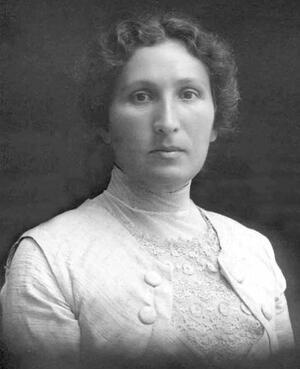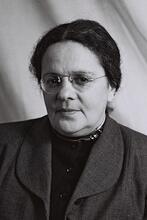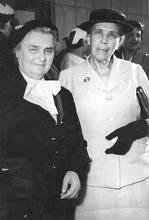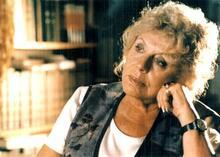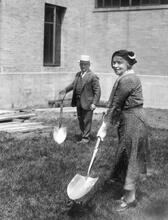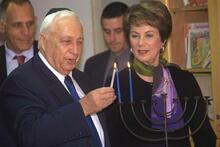Political Parties in the Yishuv and Israel
From an early age, educator and women's activist Sara Azaryahu (1873-1962) (shown here in 1915) was concerned with two major problems: the inferior status of the Jewish people and the inferior status of women. Following her aliyah she devoted the rest of her life to both the causes she held dear: Zionism and equal rights for women.
Institution: Arnan (Sini) Azaryahu
Women’s parties have played an important, though so far poorly acknowledged, role in the social and political history of Israel. They had a significant impact on women’s participation in power centers, political and others; they played a major part in the struggle for women’s right to vote and to be elected; they raised the issue of violence against women; they brought into focus the economic discrimination against women, who constitute half of the population in the labor market; they raised issues of religious discrimination of women; and they made feminist discourse about gender equality widely known and discussed. The underrating of the significance and potential of women’s parties serves to perpetuate women’s political marginalization.
Introduction: a marginalized and underrated political phenomenon
Women’s parties have been an integral part of politics in the Jewish community in Palestine prior to the establishment of the State of Israel. "Old Yishuv" refers to the Jewish community prior to 1882; "New Yishuv" to that following 1882.Yishuv and in Israel since the 1920s. Moreover, Israeli women’s parties have had far-reaching impact on women’s issues in particular and on social processes in general. However, despite the considerable implications of their existence and their potential impact on women, Israeli politics, and society at large, the phenomenon of women’s parties has hardly been recognized and only marginally studied. Most studies of women's parties emphasize their irrelevance and failure. Some exceptions are Azaryahu (1977), Freedman (1991), Safran (2006), the author (2005, 2007, and 2009) and Teitelbaum-Karrie, et al (2020). Despite their underrating, however, there are many reasons to see women's parties as having a significant impact on women's rights and political situation.
Parties representing parochial interests characterize the Israeli political system, probably more than in any other country. The most conspicuous sector with no representation by a political party in the Lit. "assembly." The 120-member parliament of the State of Israel.Knesset is women, who constitute half of the population, share distinct common interests, and experience discrimination in the private sphere, the labor market, religious contexts, the military and elsewhere. (See Abu Baker, 1988; Hasan, 1999; Hertzog, 1996; Herzog, 1996; Izraeli, 1999; Raday et al., 1995; Swirski et al., 1991; Swirski, 1993).
Studies of women’s participation and representation in politics tend to discuss women’s parties mainly in terms of marginality, curiosity, or irrelevance to political life in Israel. They imply that women tend neither to vote for women nor to support feminist-based platforms. However, since women’s parties have been a part of the political scene for many years, even before statehood, it is worth examining the widely accepted assumptions about women’s parties in Israel and demonstrating these parties’ contributions to women’s rights and opportunities in Israel.
The history of women's parties in Israel
Before statehood
Women’s parties participated successfully in all four elections to the Asefat ha-Nivcharim (Elected Assembly, the governing body of the Yishuv) between 1920 and 1944, contributing, indirectly, to the highest representation of women (fifteen percent) in the last assembly before the foundation of the state. According to Sara Azaryahu (1977), two women’s parties—the Association of Women (which for technical reasons was listed under this name but in fact had already banded together as the Union of Hebrew Women for Equal Rights in Erez Israel) and the Progressive Party—participated in the 1920 elections for the first assembly. Seven of their members were elected, two from the Progressive Party and five from the Association of Women. An additional seven were elected from the two labor parties. The fourteen women elected to the assembly of 314 members constituted 4.5 percent of the total members.
In the 1925 elections a united women’s party, the Union of Hebrew Women for Equal Rights in Erez Israel, gained thirteen seats in the assembly of 221 delegates. This again represented half of the women elected from all parties, who totaled twelve percent in the assembly. In the 1931 elections, another women’s list, Histadrut Nashim Ivriot (Hebrew Women’s Organization), joined with the Union of Hebrew Women to form a united party headed by Henrietta Szold. The three women who were elected from the United Women’s Party constituted half of all the women elected; together, they were 8.5 percent of the 71 members in the new assembly. Two women’s organizations combined forces to form a united party that participated in the fourth assembly elections in 1944. Named Women’s Association for Equal Rights and Zionist Women’s Association WIZO, they won four out of the 25 seats gained by women in the assembly. Thus, in the last assembly before the foundation of the state, women’s representation reached fifteen percent of the 171 delegates. This rate of women's representation was reached again almost 60 years later, in 2003, in the 16th Knesset.
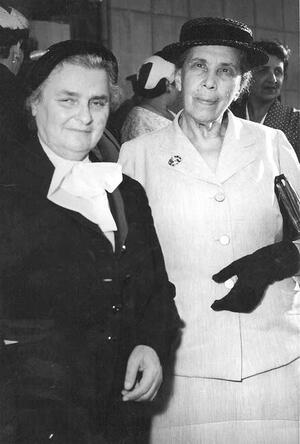
Courtesy of WIZO Archives, Tel Aviv.
After the establishment of the state
Two women’s lists participated in the 1949 elections to the first Knesset. One of them, named Ha'Isha Ve'Hapoelet Ha'datit (The woman and the religious worker), was a group of women who seceded from the religious party Nashim Zioniot Datiot (Zionist Religious Women). This party was founded in protest against the lack of women's representation in the religious party, Ha'poel Ha'mizrachi (see Rosenberg-Friedman, 2019). It failed to reach the required one percent threshold for entering the Knesset. The other, which succeeded the pre-state women’s parties WIZO and the Union of Hebrew Women for Equal Rights, entered the first Knesset with one representative, Rachel Kagan Cohen. In 1973, the Citizens’ Rights Movement, headed by Shulamit Aloni, entered the Knesset. Although it was not formally a women’s party, it was supported by feminist groups in Haifa and Tel Aviv, whose representative, Marcia Freedman, a radical feminist, was one of the three members of the newly formed party to enter the Knesset. In 1977 a women’s party, supported by Freedman and headed by Shoshana Ellings, ran in the elections but gained only a third (6,000) of the votes required for entering the Knesset. In 1992, a women’s party was founded by Shin, the Israeli Movement for Equal Representation of Women (headed by the author) and led by veteran feminist activist Ruth Reznik, who was well known for her work against violence against women. It received about 3,000 votes (about 15% of the votes needed to enter the Knesset).

Passionate, principled, provocative, and above all path breaking, Shulamit Aloni (shown here in 2001) has dedicated her life to transforming Israel into an open, just and liberal society based on human dignity, tolerance for diversity and equality. Since the 1950s, she has been a major player in the struggle for progressive stances on human rights, civil rights, religious pluralism, the status of women and Israeli-Palestinian relations.
Photographer: Yizhak Elhadar, "Scoop 80"
Institution: Shulamit Aloni
Two women’s parties were founded in 1999. One of them, Equal Representation (Yitzug Shaveh), was founded by Shin and headed by Esther Hertzog. Financial, organizational, and personal difficulties led to a traumatic gathering of the party’s active members and a decision to withdraw from the elections shortly before they took place. The same year, Pnina Rosenblum, a women’s party named after its founder, was only a few hundred votes shy of the threshold to enter the Knesset.
Three women's parties have participated in the elections to the Knesset since 2015, none of which met the threshold for entrance. The feminist awakening of ultra-Orthodox women generated a protest in 2012, titled "lo nivcharot lo bocharot" (Hebrew: "not elected—not voting"), against women's exclusion from the Orthodox parties' lists for the Knesset. Consequently, an Orthodox women's party, named "Bezchutan: Haredi Women Making Change," headed by Ruth Colian, participated in the 2015 elections to the Knesset. Although the party did not meet the voting threshold, it gained considerable media coverage. This attention can be explained by the party's unique appeal to the media, as it involved women from an ultra-religious, patriarchal background. "Simply Love," founded by Lili Weisberger, an activist in "Women Make Peace" movement, participated in the 2018 elections. In the March 2020 elections to the 23rd Knesset, "Women's Voice," headed by Dr. Mazal Shaul, also ran but failed to enter the Knesset.
Women's lists in local elections, before and after statehood
Women’s parties have also played a role in local government elections, both before and after the founding of the state. Two women, representing two women’s lists, were elected to the Jerusalem local council in 1932; four women from two women’s lists were elected in Jerusalem in 1938; one woman from a women’s list was the only woman to be elected to the council of Petah Tikvah in 1940; and one woman from a women’s list was elected to the elected body in Haifa in 1941. In 1989, a women’s list headed by Yehudith Huebner of Emunah, the women’s section of the National Religious Party, entered the municipal council in Jerusalem. A representative of a Muslim women’s list was elected in Umm al Fahm, an Arab local council, in the 1993 elections.
Local women's lists participated also in the 2018 local elections. Leviot (Lionesses), an active group of women in Ashdod, gained two seats in the town council. Its leader, Sharon Marc, was elected vice mayor. Moreover, women's growing representation in the local political sphere was evident in two Arab towns. In the 2018 local elections, a group of women activists in Osafiye, a Druze village, won a seat in the local council for its head, Samira Azam. Zeinab Hasan Abu Sweid, a Bedouin woman who headed a list of women representing three Bedouin villages, was the first Bedouin woman to become a local council member, also in 2018.
Delegitimization of women's parties
Although women’s parties and local lists have been an inseparable part of political life in Israel for the last 100 years, they have gained little public recognition in the media and academia, and even from women’s organizations. Often, other women politicians committed to male-dominated parties, have participated in this delegitimization. Various scholars have noted the tendency of women politicians to comply with their party’s expectations at the expense of women’s collective interests Thus, for instance, Hanna Herzog (1999) argues that women put the interests of the male parties before their own interests as a sector and that women politicians and women’s divisions in parties function as “gatekeepers” against other women.
Public discussions of Israeli women’s parties have exposed a variety of anti-feminist attitudes. One way of delegitimizing women’s parties has been to present them as self-evident “failures.” For example, Hanna Herzog argues that although "women are recognized, treated and organized as a social category," their "political action on the basis of their social identity has been denounced and its legitimacy denied.” Thus, she ascribed the terms “feminine,” “marginal,” and “irrelevant to politics” to the 1947 WIZO party, perpetuating the image of its failure. Similarly, Herzog implicitly denounced the 1977 women’s party, claiming that “the meager electoral achievements of the list indicated that in the Israeli political culture there was no legitimization for separate organization of women” (1999, 347).
Doron and Schoenker-Schreck also described the two women’s parties from the 1949 elections, the religious women’s party and WIZO, which gained one seat in the Knesset, as a failure. They argue that “on the basis of the 1949 two women’s parties’ experience, it can be inferred that women do not tend to vote for women … the limited scope of support indicates that a party that promises to act on women’s issues only cannot guarantee political success” (1998, 130). According to them women do not consist of a homogeneous group; although they share common problems, they are far from being “sisters in distress”; they differ from each other in age, in personal status, and in their views. According to them the most basic and common denominator, sexual identity, is not strong or attractive enough to translate it into a political power (131). Doron and Schoenker-Schreck conclude that the nearly four percent of support garnered by the 1949 women’s parties was a failure, whereas Aloni’s 1973 party, which gained only 2.5 percent support, was, in their view, successful. Similarly, Brichta argues that, self-evidently, women do not vote for women, as “women tend to reject the idea of getting organized politically in order to support women” (1975, 88). Referring to the 1949 women’s parties, Weiss claims that whenever struggles over political representation take place, women’s lists are doomed to fail (1973, 162). In a similar vein, examining the impact of the religious women's list in the first elections to the Knesset, Lilach Rosenberg-Friedman concludes that it was a failure. She argues that although the list's heads contended that it succeeded in changing women's awareness, this was not reflected in later years. She contends, further, that "looking back and facing the current political reality, the failure of the women pushed them back. Their achievements and presence in the political sphere in the Yishuv's period did not recur for many decades" (2019, 68).
Not surprisingly, the 1992 women’s party was also described as a failure and analyzed in terms of reproach. By suggesting the “natural tendency” of women to refrain from voting for women’s parties, and the “impracticality” of women’s parties in terms of “wasted” votes, scholars foster the image of self-evident, expected failure of women’s parties. Thus, for example Doron and Schoenker-Schreck state that: “Women as a target group tend to vote irrespective of their interests or their identity as women. From a practical point of view it is difficult to found a women’s party that is based on consensus over the subject of the urgency of gender equality” (1998, 140).
Dafna Sharfman, too, perceives the 1977 women’s party as a failure, but she acknowledges that this party had some significant consequences, among which were the founding of the Women’s Center and the first shelter for battered women in Haifa, by the ex-party activists.
Impact and Achievements
Although women’s parties have been hardly acknowledged and largely underrated, they have had far-reaching impact in terms of advancing women’s rights and their roles in politics and in society at large. The impact of the 1977 women’s party was evident in terms of the feminist messages presented to the public in pre-election broadcasts. The indirect influence of women’s parties can also be seen in the proportional change of women’s representation in the elections—from seven women (5.8 percent) elected in the 1988 elections to eleven (9.1 percent) in the 1992 elections. The poor rate of women’s representation lasted from 1959 (7.5 percent in the fourth Knesset) until 1992, when the 6.6 percent of the twelfth Knesset again increased to the 9.1 percent of the first three Knessets.
Among the indirect achievements of the 1977 women’s party was the appointment, for the first time, of an advisor to the prime minister on women’s status, which impacted the final report of the Prime Minister’s Commission on the Status of Women, published in 1978. This report became a crystallized version of the women’s party platform (Freedman, 1991: 150). To this day it is used as a point of reference in measuring the progress made in women’s rights. The shelters for battered women established by the 1977 party's members became an ongoing project that was expanded significantly and contributed immensely to raising public attention to the issue of violence against women.
The indirect (and unrecognized) impact of the 1992 women's party is implied in Herzog's study (1999). Referring to examples such as the founding of the women’s committee in the Knesset and its commitment to feminist interests, she suggests that some changes took place in the 13th parliament (elected in 1992). She claims that the 13th Knesset was more “friendly” to women’s issues and that for the first time two women were nominated as ministers and two women became members of the Committee of Foreign Affairs and Security. Although she does not attribute these achievements to the 1992 women's party, she states: “this is another reflection of the 1992 feminist shift, when female members demanded that men’s monopoly on security issues be broken" (349-350). The women's party must have had some impact on this "feminist shift."
While the 1999 women’s party has also been portrayed as a failure (Herzog, 1999: 346-8) it might have had an indirect impact, impelling other parties to increase the number of women in high positions on their lists of candidates. The increase in women’s representation from nine (7.5 percent) in the fourteenth Knesset in 1996 to 14 (12 percent) in 1999 might have been the indirect outcome of the "Equal Representation" (Yitzug Shave) party. The Women’s Parliament, founded by the author a short time after the 1999 elections, is one of the outcomes of this women’s party. The Women's Parliament is a feminist political forum that promotes alternative thinking about political and social issues; it carried out over 100 sessions that took place all over the country. Its discussions were followed by various social-feminist activities, including an anti-pornography coalition and a Jewish-Arab women’s leadership group.
The groundwork for these gains was laid by the pre-state women’s parties, which were most effective as a means of pressuring the parties to enlarge the proportion of women on their lists, impacting the pre-Knesset institution. Thus, “in the first three elected assemblies the number of female representatives elected via the ‘women’s list’ was almost always equal to the number of women representatives elected through the lists of all the Yishuv parties together. But in the fourth elected assembly [in 1944] the ‘women’s list’ constituted only twenty percent of female representatives elected by parties and fractions” (Azaryahu 1977, 56–57). Also, the percentage of elected women grew from ten percent in the third assembly to fifteen percent in the fourth—a proportion nearly achieved again only in 2003. Azaryahu describes in detail various crucial struggles and achievements of the Association for Women’s Rights, in matters such as inheritance, property, guardianship and bigamy.
The example of Rachel Kagan Cohen, the WIZO representative in the first Knesset, who proposed The Law of Equal Rights for Women passed in 1951, is evidence of women's parties' significant influence. The law grants married women equality in civil matters—the right to sign a contract, to own private property, and to take legal action. Kagan Cohen's legislative proposal also included a section that promised legal validity for civil marriage and divorce laws, but this was rejected. Imperfect though it was, this law became the first feminist law of the new state and the basis for significant developments in the legal rights of women in Israel.
Thus it may be said that since the 1920s, women’s parties have contributed significantly to political, legal, and social achievements of women in Israel. Women’s parties have been the catalyst for increasing the representation of women and for accelerating feminist awareness and activities throughout the gendered history of Israel in the twentieth century. The important aspect that has been overlooked or ignored is that women’s parties have since pre-state days played a major part in some of the most important social processes in the country. The extent of their impact on issues such as violence and gender power relations in the family, basic human rights, political and economic equality, and social struggles generally demands feminist and public acknowledgement as well as open-minded study.
Conclusion
Women’s parties have played a major, though so far poorly acknowledged, role in the social and political history of Israel: they had a significant impact on women’s participation in power centers, local and national, political and others; they played a major part in the struggle for women’s right to vote and to be elected; they brought into focus economic discrimination against women, who constitute half of the population in the labor market; they made feminist discourse about gender equality widely known and discussed. Indeed, these and other achievements cannot be separated from the impact of the feminist activity in Israel and abroad. Moreover, the last decade's development of virtual feminist social networks has contributed to women's struggles, such as the one against the sex trade and sexual harassment, and indeed to women's political representation. The fact that women's parties' importance has been poorly acknowledged reflects the fact that women as a sector are marginalized and discriminated against in the writing of Israel’s history.
The underrating of the significance and potential of women’s parties serves to perpetuate women’s political marginalization. Ignoring the significant impact of the women’s parties appears to put off any major change in the gender-power relations in society. The lesson to be taken from the electoral and feminist successes of the pre-state women's parties is that ongoing feminist activity and cooperation of all main women's organizations and feminist groups, involved in struggles for social and gender equality, are essential for entering and participating in power centers, whether political or others.
Hebrew
Abu Baker, Khawla. A Rocky Road: Arab Women as Political Leaders in Israel. Ra’annanah: 1988.
Azaryahu, Sarah. The Union of Hebrew Women for Equal Rights in Eretz Israel: A Selected History of the Woman’s Movement History in Israel: 1900–1947. Haifa: 1977.
Doron, Gideon and Schoenker-Schreck, Danielle. Waiting For Representation: Women in Politics. Tel Aviv: 1998.
Hasan, Manar. “The Politics of Honor: The Patriarchy, The State and Women’s Murder in the Name of Family Honor.” In Sex, Gender, Politics: Women in Israel, edited by D. N. Izraeli et al. Tel Aviv: 1999, 267–306.
Hertzog, Esther. “Aspects of Gender Inequality in the Education System.” In Education Times: The Educational Supplement of High School Teachers in Israel, edited by H. Maron. Tel Aviv: 1996, 6–24.
Idem. "Women's Parties in Israel: Their Importance, Impact and Potential." Social Issues in Israel 7 (2009): 6-45.
Herzog, Hanna. “Women in Politics and Women’s Politics.” In Sex, Gender, Politics: Women in Israel, edited by D. N. Izraeli et al. Tel Aviv: 1999, 307–356.
Izraeli, Dafna N. “Genderization in the Military Service in Israel.” Theory and Criticism 14 (1999): 29–52.
Freedman, Marcia. Exile in the Promised Land: A Memoir. Tel Aviv: 1991.
Raday, Frances, Carmel Shalev and Michal Liban-Kobi, editors. Woman’s Status in Society and in the Law. Jerusalem and Tel Aviv: 1995.
Report of the Prime Minister’s Commission on the Status of Women. Jerusalem: 1978.
Rosenberg-Friedman, Lilach. "The Religious Women's List in the First Elections to the Knesset: A Failure or Achievement?" Iyunim, 32 (2019): 35-72.
https://in.bgu.ac.il/bgi/iyunim/32/Lilach-Rosenberg-Friedman.pdf
Safran, Hannah. Don't Wanna Be Nice Girls: The Stuggle for Suffrage and the New Feminism in Israel. Haifa: 2006.
Sharfman, Dafna. Women and Politics. Haifa: 1988.
Swirski, Barbara. “Control and Violence—Women Beating in Israel.” In The Israeli Society: Critical Perspectives, edited by U. Ram. Tel Aviv: 1993, 201–221.
Teitelbaum-Karrie Naama., Nurit Jacobs-Yinon., Margalit Shilo. "The Hebrew Suffragists – One Hundred Years of Women's Activism in Israel." Deot 92 (2020).
Weiss, Shevah. The Politicians in Israel: Representation, Resources and Styles of Recruitment. Tel Aviv: Achiassaf. 1973.
English
Brichta, Abraham. “Women in the Knesset 1949–1969.” Parliamentary Affairs 28 (1975): 31–50.
Hertzog, Esther. "Women's Parties in Israel: Their Unrecognized Significance and Potential." Middle East Journal, 59, 3 (2005): 437-451.
Idem. "Women’s Political Parties in the Yishuv and Israel". In (eds.) Jewish Women, A Comprehensive Historical Encyclopedia, edited by P.Y. Hyman & D. Ofer. Jerusalem: 2007.
Herzog, Hanna. “Why So Few? The Political Culture of Gender in Israel.” International Review of Women and Leadership, 2 (1996): 1–18.
Swirski, Barbara and Safir, Marilyn, editors. Calling the Equality Bluff. New York: Pergamon Press, 1991.

